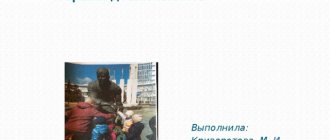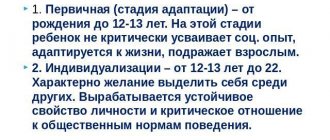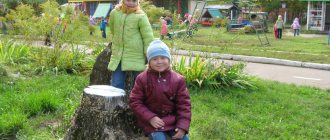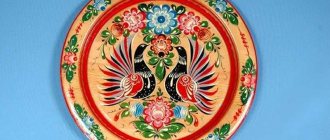Productive activities for preschool children
Productive activity of preschoolers is the right direction in preparing the future first-grader for education.
The formation, development and formation of a child’s personality is one of the most relevant, important and responsible areas of activity for specialists involved in the field of pedagogy and child psychology. One of the main tasks that must be constantly performed in this direction is the use of various styles, forms and methods, including productive activities.
Modeling and applique
The peculiarity of modeling is that a child can create a three-dimensional image of cars, animals, fruits and other favorite objects. The topics are very diverse. Modeling has a great effect on fine motor skills, develops imagination and a sense of space, because after making objects they can be placed further or closer to each other, and satisfies children’s needs for knowledge and creativity.
By creating applications, children learn to independently cut out objects, place them in the right places, and stick objects and elements onto paper. Here, again, the development of finger motor skills and coordination are involved. To create an applique, you need to think hard, think creatively, because the details rarely contain whole and clear objects, so you need to compare them correctly. In addition, the preschooler gets acquainted with mathematics by studying simple geometric shapes. The idea of the placement of objects in space (in the corner, in the center, on the right or left) and the size of parts (large or small triangle) also develops.
You can make a mosaic not only from pieces of paper, but also from lumps. This is also quite entertaining, and no less useful for development.
Important
Productive activities of children play one of the main roles in the process of comprehensive development of a preschooler. Along with the game type, they constitute a single complex of work on preschool education, carried out under the guidance of adults (teachers, educators). The result of this activity should be a specific product.
Numerous studies conducted by specialists in different parts of the world and with different categories of children who have not yet reached primary school age have shown the effectiveness of productive activities among this age group of children.
A beneficial effect on preschoolers has been established in the development of graphic skills, as well as the development of perseverance and determination in mastering important skills.
Lesson results
It is necessary to create a system of activities for children. If the teacher correctly distributes productive activities, and all its types are involved, the result will be as follows:
- children will be developed creatively;
- the group will have an excellent psychological atmosphere;
- preschoolers will be well prepared for school classes.
Most often, productive activity connects several areas, such as creativity, socialization, cognition, labor, communication, and the safety of preschoolers. Artistic and productive activities and creativity help develop a child’s speech. At this age there are many problems with her, such as poverty (poor vocabulary), monosyllabicity, it consists only of simple sentences, and the words are far from beautiful and literary. For example: “what”, instead of “what”, “beautiful flower”, instead of “I like this flower because...”, but instead of “I don’t want this because...” you can hear “leave me alone”, and others expressions. Children need to be taught to speak beautifully and explain their preferences more fully and efficiently.
In addition, children receive moral education, consolidate the knowledge acquired in the learning process, and develop the necessary character qualities:
- activity;
- independence;
- observation;
- determination;
- patience;
- the desire to finish what you started;
- the ability to “sort out” the information received and assimilate it.
Productive activity also improves the physical condition of children. They become more cheerful, their mood improves, their overall tone increases, their character becomes more relaxed and active. After classes and during them, the child is active. It is important to immediately correctly form his posture, gait, and body position, because all these qualities will be useful to the little man in the future. Productive activity allows you to coordinate movements, “tune” the vestibular apparatus, and strengthen the muscles.
Now we propose to get acquainted with the main types of productive activities. And at the same time we will note the features of each.
Definition
Productive activities of children are one or another way of a child’s activity, the goal of which is to obtain a product that has a specific set of qualities. This category includes:
- different ways of assembling structures,
- crafts made from plasticine or special clay,
- performing appliqué work, mosaics,
- making various crafts,
- more complex work - certain layouts.
All productive activities of children listed above perform a responsible function for the development of preschoolers. This is the basis of many kindergarten programs designed for children under school age. This program is aimed at their comprehensive development and education.
Productive activity as a means of development of preschool children
Bibliographic description:
Dubova, I. A. Productive activity as a means of development of preschool children / I. A. Dubova. — Text: immediate // Current issues of modern pedagogy: materials of the X International. scientific conf. (Samara, March 2021). - Samara: ASGARD Publishing House LLC, 2021. - pp. 38-40. — URL: https://moluch.ru/conf/ped/archive/212/11891/ (access date: 11/21/2021).
According to the provisions of the Federal State Educational Standard for Education, in preschool educational institutions at the present stage, work with preschoolers is organized in accordance with the principles of developmental education and attention is focused on personality-oriented and integrative approaches. Within the framework of the activity approach, the educational process of a preschool educational organization (hereinafter - PEO) is built taking into account the principle of including the personality of each child in meaningful activities. Along with the leading activity of a preschooler - play - one of the significant activities of a preschooler is productive activity.
This includes designing from building materials and various construction sets, waste materials, assembling mosaics, embroidering, drawing, sculpting and appliqué. According to L. Yu. Alekseeva, “these activities differ from games in that they are associated with the creation of some final product - a drawing, construction, crafts, and so on. These actions develop not only imaginative forms of thinking, but also such qualities as purposefulness, the ability to plan one’s activities, and achieve a certain result” [1, p. 176].
All productive types of children's activities are aimed at creating one or another result. Each of these types of activities requires mastery of a special way of action, skills and ideas. For example, in preschool educational institutions they use subject, plot and decorative drawing. In this activity, it is important not to allow traditional graphic images to be consolidated and turned into templates, but to stimulate the child’s own creativity.
Therefore, according to the team of authors: M. V. Dyuzhakova, O. I. Lavlinskaya, A. V. Kolomeets, the teacher “should encourage children to use a variety of tools, materials and image techniques, including non-traditional ones: monotype, poking with a hard semi-dry with a brush, drawing with fingers, cotton swabs, palm, imprinting with cork, foam rubber, polystyrene foam, eraser and potato stamps, crumpled paper, stencil printing, regular blotography, with a thread, with a tube, embossing, spraying, leaf prints" [4, p. . 581].
At the same time, it is important to maintain children’s interest in this activity, and the use of non-classical image options, various materials and tools should contribute to the creative development of children, but not become an end in itself. Modeling from plasticine or clay is a very exciting, interesting, and useful activity. In recent years, according to the authors R. G. Kazakova, T. I. Sayganova, E. M. Sedova, V. Yu. Sleptsova, T. V. Smagina, “salt dough and paper pulp have become very popular materials for modeling. In kindergarten, three types of modeling are used: object modeling (the child sculpts a single object), plot modeling (depicting the actions of several characters or a character and objects), decorative modeling (dishes; objects of decorative art, whistles, nesting dolls; decorating flat forms with a variety of three-dimensional details )" [5, p. 6].
Another type of productive activity - appliqué - allows the child to become familiar with different ways of working with paper. Children get acquainted with different techniques of paper cutting (symmetrical, silhouette, ribbon); master various methods of creating an expressive image (tearing, crumpling, twisting, bending, folding), gluing paper or its individual parts; learn how to use scissors correctly and safely. It is possible to perform an application with elements of drawing, design, construction; using various materials (fabric, leaves, seeds, straws, etc.).
Design is a purposeful process of solving technical problems that involve the creation of buildings, bringing objects, their parts and elements into a certain relative position. There are three types of constructive activity of a child:
− according to the sample;
− according to the conditions;
- by design.
All types of construction are interconnected, each type develops specific abilities. For construction in kindergartens, large (floor) and small (tabletop) building materials are used, as well as construction sets with variously complex methods of connecting parts, and constructive puzzle games. According to S. Klimova and Y. Chichilanova, “LEGO construction is becoming very popular in working with preschoolers. Preschoolers are happy to build buildings from sand and snow, where they independently plan their activities, play with the buildings, and work together” [6, p. 95].
Artistic (manual) labor is a type of productive activity closely related to design and application. Origami-type works are made from paper and cardboard; make attributes for games, costume elements, decorations; finger and table theater; they make doll furniture, houses, cars. Natural and waste materials (foam rubber, large and small beads, polystyrene foam, eggshells, wire, flower and plant seeds, cereals, beans, leaves) are used for making crafts, jewelry, and gifts. With the help of threads and fabric, children master the basics of sewing, knitting and weaving macrame.
In the process of productive children's activity, the child's visual memory is actively formed, children's speech, imagination, visual-figurative thinking, perception, attention, ability to analyze and generalize develop. Children intensively develop sensory and mental abilities, eye, gross and fine motor skills of the hand, coordination of movements, accuracy, perseverance, perseverance, determination, and the ability to complete the work started are formed. Preschoolers learn to act in given conditions, plan and jointly discuss a plan, create dynamic expressive images and collective plot compositions, show activity, initiative, independence and creativity.
In addition, children's mastery of productive activities prepares children for school. When organizing productive types of children's activities, the teacher must ensure the child's emotional stability throughout the entire period of activity, create motivation for the upcoming work, select a task in accordance with the capabilities, interests and preferences of the children, provide free access to artistic materials, and provide the right to independently determine the course of action for achieving goals, providing assistance in realizing the importance of personal participation in collective creativity, recognizing children's achievements.
As the authors O.V. Berezhnova and L.L. Timofeeva note, “adults offer children tasks that develop in children the ability to invent, anticipate, conjecture, and transform; encourage the construction of individual, complex and collective buildings (as planned and based on drawings and diagrams). Since the perception of a preschool child is holistic, his learning should be carried out in ways that are adequate for him: not by dismemberment, not by dividing the cognizable object into separate components, but integratively” [2, p. thirty].
Productive activities make it possible to enrich and diversify work with children in the implementation of all educational areas according to the Federal State Educational Standard for Education. Let's look at the example of organizing work on the mathematical development of preschoolers. Children use the knowledge acquired in the design process (geometric planar figures and volumetric forms; concepts of top, side, angles, parts and the whole; transformation of flat shapes into volumetric ones; spatial relationships). To consolidate the image of numbers, you can invite children to lay them out from sticks, cord, pebbles, shells; mold from dough, plasticine; redraw the number from the outline onto cardboard, fill it with plasticine and decorate if desired. You can involve children in making collages from studied geometric shapes and numbers, composing fairy tales with mathematical content and illustrating them.
Pedagogical interaction is carried out in the format of joint activity between the teacher and the child. According to T. N. Doronova, “it is distinguished by the presence of a partner position of an adult and a partner form of organizing activities. Forms of organizing joint activities of adults and children: workshops for children’s creativity, exhibitions of fine arts, vernissages of children’s creativity, creative projects, classes in an art studio” [3, p. 61].
In the educational process of preschool education in the life of a child, there must be a place for free productive activity, which is carried out in a certain developmental subject environment that stimulates children to demonstrate independence and creativity, the development of children's interests, where there is an opportunity to participate in collective actions with peers and act independently . A necessary condition for free productive activity is the availability of a variety of aids and materials, which should be freely available and in sufficient quantity. The child can decide for himself what materials, when and how to use. The role of the teacher in this case is to, together with the child, develop a plan and method of his activity, provide a set of materials that corresponds to the interests and stimulates the child’s personal development.
We can say that familiarity with techniques, the use of various forms of joint activities, the creation of conditions for independent children's activities, and the skillful guidance of an adult stimulate children's interest in productive activities, which are an effective means of the holistic development of preschoolers.
Thus, the main types of children's activities in the preschool period are playful and productive. Productive activity in preschool education is the activity of children under the guidance of an adult, as a result of which a certain product appears. Numerous studies have shown that it is productive activity that contributes to the development of graphic skills in children of senior preschool age, fosters perseverance, imagination, creates pedagogical conditions for the process of socialization of senior preschool children and, along with play, is of greatest importance for the development of the psyche during this period.
Literature:
- Alekseeva L. Yu. The importance of productive activity for children of senior preschool age / L. Yu. Alekseeva // Preschool education: experience, problems, development prospects: materials of the IX International. scientific-practical conf. (Cheboksary, September 30, 2021) / editorial board: O. N. Shirokov [and others]. - Cheboksary: CNS "Interactive Plus", 2016. - No. 2 (9). — pp. 176–178.
- Berezhnova O. V. Stage of constructing a model of the pedagogical process / O. V. Berezhnova, L. L. Timofeeva // Design of educational activities in kindergarten: modern approaches: Methodological manual. - M., 2013. - pp. 30–32.
- Doronova T. N. Workshop / T. N. Doronova // Success. Joint activities of adults and children: basic forms. - M. - 2013. - P. 61–64.
- Dyuzhakova M.V. Productive activity as a means of development of a preschooler / M.V. Dyuzhakova, O.I. Lavlinskaya, A.V. Kolomeets // Collection of materials of the Annual International Scientific and Practical Conference “Education and Education of Young Children”. - 2016. - No. 5. - P. 580–583.
- Kazakova R. G. Non-traditional graphic techniques / R. G. Kazakova, T. I. Sayganova, E. M. Sedova, V. Yu. Sleptsova, T. V. Smagina // Drawing classes with preschoolers / Ed. R. G. Kazakova. - M. - 2008. - P. 5–31.
- Klimova S. LEGO constructor as a means of integrating educational areas in the process of teaching older preschoolers / S. Klimova, Yu. Chichilanova // Preschool education. - 2015. - No. 4. - P. 95–99.
Key terms
(automatically generated)
: productive activity, child, LEGO, waste material, kindergarten, children's creativity, productive type of children's activity, productive type of activity, free productive activity, building material.
Comprehensive development
The formation of this type of activity for children takes place in kindergarten under the guidance of experienced specialists. At this time, the connection between the children’s desire to create this or that product and the expansion of their cognitive abilities, various processes and qualities, the emotional area, and the volitional sphere of development is most clearly manifested.
The most vivid and controlled development of children’s character traits occurs, the formation of their character and individuality.
It is also interesting to read what features the speech development of an older preschooler has.
CONSTRUCTION
This type of activity plays an important role in preschool age, so various mosaics and construction sets should be in every home. In addition, you can create crafts from natural and artificial materials and even from paper.
This kind of work is undoubtedly useful:
- children improve their coordination of movements, fine motor skills and spatial orientation;
- their thinking and imagination improves;
- artistic taste develops, the ability to see the beauty of one’s own creations and objects of the surrounding world;
- the child receives the most important information about such complex concepts as shape, color, size, position in space.
All this, without a doubt, will be useful in the first grade, as well as perseverance, patience, the ability to overcome difficulties, set a goal and achieve it, therefore constructive activity must be present in homework.
To make it interesting for children, you should offer them a variety of tasks:
- making gifts for parents or friends for the holidays;
- creating your own garlands and Christmas tree decorations for the New Year;
- designing your own book of fairy tales;
- preparing scenery for a puppet show;
- if several children are participating, you can organize an exhibition or a sales exhibition, for which various “exhibits” are made in advance.
Such projects are not only useful for preschoolers, but also interesting, and therefore will be productive. It is clear that the work should be consistent and follow the principle “from simple to complex”, that is, first you need to teach the child specific actions - draw, glue, cut - and only then offer to invent and design something.
All this will help develop your child’s creative abilities and successfully prepare him for school.







